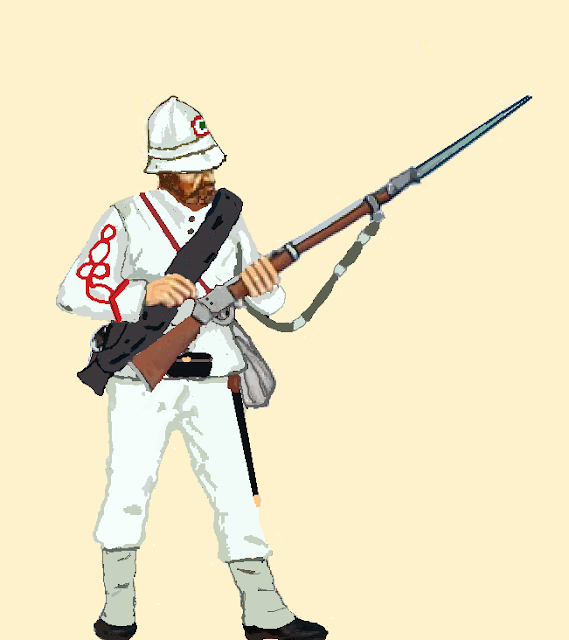As far sa I know, even on Italian sources, there is no map of this battle. The only map I found is published on the excellent (absouluttly worthy to buy) "Le Guerre Coloniali Italiane 1885/1900 by Raffaele Ruggeri, published by E.M.I. Serie "DE BELLO". The text is all in Italian,while some part of it is translated in English too.
Here the map:
MAP OF THE BATTLE OF DOGALI
from Le Guerre Coloniali Italiane 1885/1900 by Raffaele Ruggeri, published by E.M.I. Serie "DE BELLO"
I decided, as Italian and as lover of historical facts and events, that this lack must be filled up. So I went on Google Maps, I checked the zone of Dogali and from this I drew my map. Here the first result:
 |
MAP 1
General map of the zone of the Battle of Dogali
In the red square in the following map the zone of the Battle of Dogali.
The zone of the Battle of Dogali (in the red square)
From the map nr.1 I put in evidence the part on the very right (from Massaua) to show the Italian relief coloumn, with the very details of it.
MAP 3 The Italian Relief Coloumn
The Italian Coloumn was formed in this way:
MAP 3Bis Deatils of the Italian Relief Coloumn
The following map shows the situation at 8.30 AM, 27 January 1887. The Bazi-Bouzok just scouted the advancin Abyssinian forces and engage them (position 1 and 2), while the Italian relief coloumn turns right (position 3) to reach the little hill. Please note the typical Abyssinian formation in Greek Cross formed by other smaller Greek Cross. It has a religious meaning and also a tactical use. The Abyssinian Army was never moving in coloumn but in Greek cross formation (the territory allowed this tacticts) and it was the same formation that would have smashed on the enemies. It is quite interesting this tactic. (see further legenda)
Battle of Dogali at 8.30 AM
In the following map the detail of one of the crosses with the name of the Commander of every sigle arm of it.
|

MAP 5
Name of the Commanders of the Greek Cross of the Abyssinian Army
I also found an old postcard with the visual on the plain (Nr. 2 in red), where the Italians defended themselves. The point of view is from the Abyssinian attack (Nr. 1 in red); this picture is very interesting because gives the idea of the battlefield and how open the spaces were, with no possibility to find a shelter.
MAP 6
The Battlefield of Dogali
A better view of the battlefield from the old postcard
In the following map the focus on the situation at 8.30 AM. I put in evidence on the Mehatel Hill the part with a steep slope (edge in black)
MAP 7
Battle of Dogali. 8.30 AM. Details
Battle of Dogali h 9.30 AM
Reaching the defensive position
1) The main Italian Coloumn is rushing towards the Mehatel Hill to take defensive position
2) The supply rearguard is taking position on the second and smaller hill, but towards the enemy
3) The Abyssinian Army is heading towards the Mehatel Hill to catch up with the main Italian Coloumn, leaving the rearguard to deal later with the supply coloumn
4) The screen of Bazi-Bouzok slow down the advance of the Abyssinian and then the leave the zone
MAP 8
Battle of Dogali h 10.30 AM
Holding the first defensive position
The Italians are defending the first position on the Mehatel Hill in a semi-circular formation (1) while the Abyssinian are attacking in front (2); the coloum with camels (3) is on the little hill already surrended; the Abyssinanian (4) are manoevering to encircle the defensive position of the Italians.
MAP 9
Battle of Dogali - Final phase





































